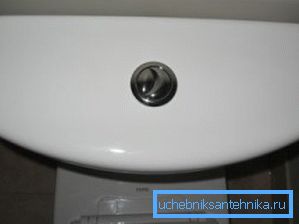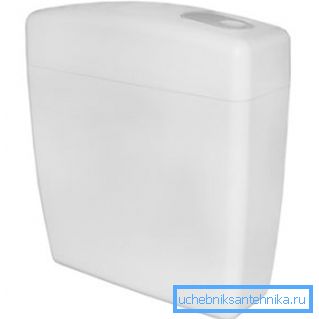Toilet cistern - main types and their design features
Any plumbing system effectively operates only with the correct operation of all its parts. Drainage tanks for the toilet bowl are rarely considered separately; meanwhile, the comfort of operation largely depends on this part of the design - high-quality drainage, fast and silent filling of the container, etc.
Consider what are the tanks and the different options differ from each other, it will allow you to better understand the operation of the system and quickly identify faults in the event of their occurrence.

Criteria for the effective operation of the tank
If you can not decide which of the options fits best to your toilet, you should consider each for compliance with several basic requirements:
| Efficiency | The constructions should be provided with a quality flush, for this the tank should have a sufficient volume of water and create an optimal pressure (it should not be too strong, otherwise the whole room will be constantly splashing). Again, insufficient pressure will not provide high-quality removal of wastewater into the sewer system. |
| Reliability | Price should not be a fundamental factor when choosing a product, as a quality product will never be worth very little. At a minimum, you need to choose options from the average price range, and it is better to pay attention to the products of leading brands that have earned a good reputation among buyers and specialists. |
| Compatibility | The design should be combined with the main unit - the toilet. In this case, care should be taken to match not only the color, but also the shape of the product and the stylistic direction. Square containers in high-tech style are unlikely to look organically with a classic-style toilet bowl. |
| Simplicity and functionality | Most designs can be easily installed with your own hands. As a rule, the complete set always includes an instruction in which, with the help of diagrams, the procedure for assembling valves and the installation and mounting features of the tank itself is explained. Remember the golden rule: the simpler the design, the less the likelihood of damage, you should not choose too clever options |
Tip! When choosing a particular option, pay special attention to the quality of the product, the surface should be smooth, without any flaws, the color - uniform, without streaks and stains. Nowhere should there be cracks, especially at the points of attachment and abutment to the outlet, it is also important to pay attention to the seals that come with the kit, they must be elastic, without cracks and deformations.

Features of the device of various systems
The cost of a toilet cistern for a toilet bowl largely depends on its design and features of functioning. Therefore, we consider the most important differences between the different options and their advantages.
Tank location
There are three main options:
- Classic systems, when the container is located directly on the shelf of the toilet bowl, is the most popular option due to the very easy installation and simplicity of design.. The design is connected with two bolts, the outlet is sealed with a ring. One of the advantages is the ease of repair and maintenance, since access to all nodes is unlimited.

- Another common type is the location of the cistern above the toilet bowl, this layout was the most popular in the Soviet era.. Elements communicate with each other through a pipe, the length of which may vary. The high quality of the flush can be attributed to the pluses due to the quality of the pressure, the disadvantage is the inconvenient location of the tank to repair it, you will need a stepladder.

- The newest option is hidden systems that are installed on a special frame - installations and are closed with facing materials.. At the same time, the tank is made of plastic, and the drain control is implemented through a button, which can be either mechanical, pneumatic or even touch-sensitive. If you decide to find out how much such a system costs, you need to sum up the prices of all the elements, since they work only in the complex.

Type of trigger
There are several main options, we will consider each of them separately:
- The mechanism with a handle - in it, to enable flushing, you must pull the handle up and open the shut-off valve. It was used most of all in the 80s-90s, nowadays it is used much less often due to its low economy: water consumption is always the same. However, in some cases, this option is best suited for the style.
- Push-button system is the most popular and widespread today.. This is due to the simplicity of the design and its functionality: there are two modes of flushing - full and partial, when only half the volume is poured out. This solution allows you to save water, in addition, the design has a low noise level in the process.

- The lever type of mechanism is used most often in suspended structures, to activate the flush it is necessary to pull the chain. In the old versions, the amount of water depended on the time that you hold the craving; in modern times there can be two modes that depend on the force with which you pull the lever. In general, the system is quite simple and reliable and has a long service life.

Tip! If you have good audibility, it is better not to install systems with suspension tanks - in them flushing happens quite noisy, which can create some discomfort during operation.
- And, finally, the most modern solution is an automatic toilet flush.. In this case, no buttons are installed; there are sensors on the toilet and in its lid that work after a person has got up or closed the lid. They include automatic flushing, which is very convenient.

Manufacturing material
Tanks can be made of the following materials:
- Cast iron - was widely used earlier, nowadays it can still be found in the buildings of the old building. Of the advantages, we can highlight the high strength, but the minuses are much more: susceptibility to corrosion, the need for constant staining outside, unattractive appearance, great weight.
- Faience is the most widely used material for the manufacture of tanks, this material has an optimal price-performance ratio and is excellent for use in plumbing. Of the minuses can be identified not very high surface quality, but this problem is solved by applying a glaze.
- Porcelain is considered the best material for plumbing and is used for the production of tanks from a more expensive price category. Products have an attractive appearance and a smooth surface that is resistant to the appearance of plaque.
- Plastic is used to make containers in hidden systems.. The volume of this type of toilet cistern can vary, so it is important to choose an option with a capacity of at least 5-6 liters. In addition, the size of the structure and the quality of the material are important. Also, plastic is used in the most budget modifications.

Conclusion
The choice of a quality tank is no less important than the choice of a good toilet bowl. Of course, the easiest way to buy a product in the kit, but if suddenly it didn’t happen, then our review will assist in making the right decision.
The video in this article will help to understand some issues even better.